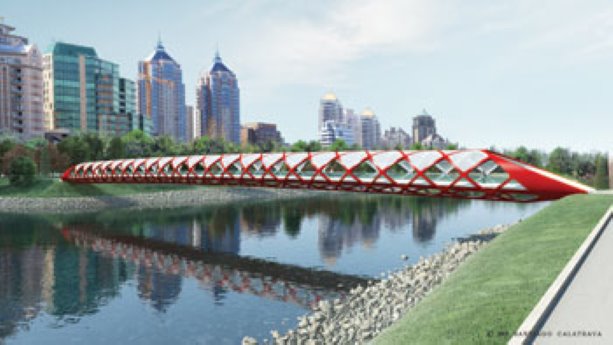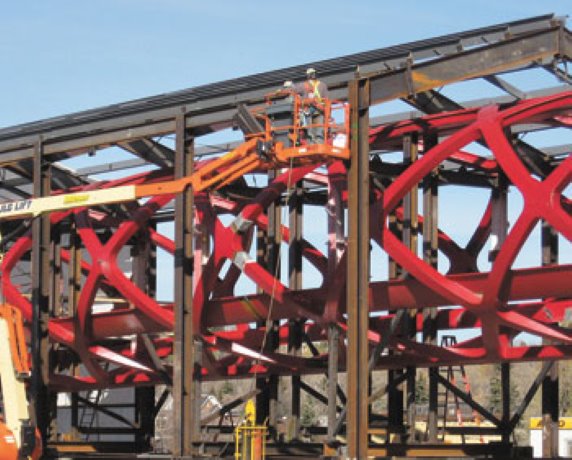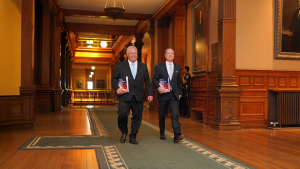The timeline to complete the construction of the Peace Bridge in Calgary, Alberta has been extended due to the complexity of the project and the advanced nature of the design.
The timeline to complete the construction of the Peace Bridge in Calgary, Alberta has been extended due to the complexity of the project and the advanced nature of the design.
“The Peace Bridge is not only a complex piece of engineering work, it is also a work of art,” said David Danchuk, acting communications leader in transportation with the City of Calgary.
“To complete this project appropriately, we need more time to assemble the pieces of the bridge.”
Construction on the $24.5 million Peace Bridge, that will span Calgary’s Bow River and connect Eau Claire to Sunnyside, began on site in March 2010.
Graham Infrastructure Ltd. is responsible for the assembly of the bridge structure.
“The contractor is assembling all of the structural pieces,” said Danchuk. “The entire length is inside an enclosure on the south bank of the river to make sure the welds are done properly.”
The tubular steel structure was fabricated by Augescon in Spain and shipped to Canada in September.
“By the time the structure got here, they sent a worker to help the contractor finish the fabrication welds,” said Danchuk. “All sixteen pieces of the bridge are here and have been put in position. They will also come back to do an inspection and make sure the installation goes correctly.”
Assembly of the components will take place on a platform within the construction zone. A temporary shelter is being used to create an appropriate work environment for welding, painting and other activities.
There are two reasons why the quality of welding is a significant factor for this project.
The first is the 130-metre long bridge will be the longest single span structure in Calgary.
The overall structure acts as one unit, so the strength of the assembly welds is critical.
The second factor has to do with the aesthetic appearance of the finished bridge.
“The only problem we ever had with the project was the aesthetic of it,” said Danchuk.
The bridge was designed by award-winning Spanish architect Santiago Calatrava, who requires a smooth exterior finish. This means that the section joints should not be easily noticed.
“This is a unique structure that requires a lot of time and attention,” said Danchuk. “We have flexibility with time, but not quality and the budget.”
According to Danchuk, the construction time will need to be extended because of the complexities of construction, which include fitting, splicing, welding and the high quality finishing required.
Due to the unique and advanced nature of the design, the onsite assembly has been a learning process for Graham Infrastructure.
The contractor had to rethink the assembly methodology, as a result of the experience they gained working through the various stages of assembly.
A temporary structure has been constructed just upstream of where the Peace Bridge will ultimately cross the Bow River. This structure will be used to assist in the assembling of the bridge.
The deck will be a combination of cast-in-place and pre-cast concrete.
The glazing will be supplied by the Austrian company, GIG Fasseden. The piling subcontractor on the project is Big Eagle Services.
In order to minimize the environmental impact of construction and permanent bridge installation, the bridge is designed to span the river with no support structures.
Completion of the bridge was originally scheduled for late 2010, but it is now expected to be finished in the middle of 2011.
It will be used by more than 5,000 people daily.
Just after municipal elections last October, it was widely reported in the media that the project was six months behind schedule due to problems with the welding done in Spain by the manufacturer. At that time, it was thought that the work would have to be redone.
Danchuk said it was likely a misunderstanding because some components were spot welded, so the ocean shipment could make the cut off for a vessel from Spain.
“This was political non-sense run amok,” said Danchuk. “What occurred is we just had an election and one of the incumbents on the city council was a strong opponent to the Peace Bridge project.”
The bridge’s design was awarded through a single-source contract and critics said this should have been done through a competitive tendering process. They argued that the bridge would be far too expensive and should have been designed by a local firm.
The majority of the project was tendered through competitive processes, including construction, geotechnical investigation, hydrotechnical reviews, electrical designers and construction supervision.












Recent Comments
comments for this post are closed